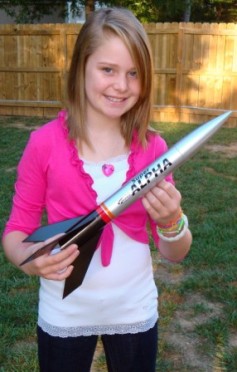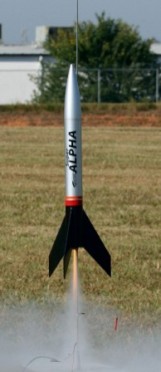| Construction Rating: | starstarstarstarstar_border |
| Flight Rating: | starstarstarstarstar_border |
| Overall Rating: | starstarstarstarstar_border |
| Published: | 2010-12-12 |
| Diameter: | 1.64 inches |
| Length: | 19.50 inches |
| Manufacturer: | Estes  |
| Skill Level: | 1 |
| Style: | Sport |

Brief:
An upscaled version of the classic Alpha that flies on standard Estes 18mm engines. Almost 20 inches tall, this rocket reaches heights of 600 feet.
Construction:
Balsa Nose Cone, Laser-cut Balsa Fins, Cardstock Centering Rings, Engine Hook, BT-60 body tube, and waterslide Decals
The motor mount is constructed using typical methods. The only thing I changed was to add a Kevlar shock cord that ties around the motor tube between the upper and lower centering ring. I used a small amount of wood glue inside the body tube and the motor mount was inserted into the BT. The next step was to I fill the spirals. After sanding the BT, the tube was marked for the fin locations and the launch lug. The laser-cut fins are made from 1/8 hard balsa. The fins leading edge was rounded and they were glued onto the BT using a very small amount of 5 minute epoxy. Once the fins were attached and allowed to dry, small epoxy micro balloon fillets were created around the fins and launch lug to add some strength and to clean up the joints. The launch lugs was attached to the bt using epoxy as well. The kit provides one long launch that I cut in half and installed them on the bt about 7" apart.
The only con was the nose cone. It was made from hard balsa which is good, but it was very heavy. I used the stock cone so it's no big deal. However, because of the weight of the cone hitting the advertised weight of 2.2oz is nearly impossible.
Finishing:
I sealed the balsa fins and nose cone with two coats of Minwax Polyurethane. Once dry they were sanded smooth and coated using thinned spackle that was brushed on to fill the wood grain. The filler was sanded off and the rocket was primed with two coats of Dupli-Color High Fill Primer sanding between coats. The Super Alpha was painted silver with Dupli-color, and the metallic black was Rustoleum. Once the body was allowed to completely dry the Super Alpha decal was applied. The decal applied easily with no issues.
Construction Rating: 4out of 5
 Flight:
Flight:
I flew the Super Alpha three times on the first day. I used an Estes C6-3, Estes C6-5, and a Quest C6-3. Preparation is very easy since the BT-60 gives you plenty of room to pack the chute. All three flights were perfect, stable, and recovered close to the pad. On one of the flights the nose cone impacted the top of the BT causing very minor damage that was easily fixed.
Recovery:
The supplied 18" 'chute is a little on the large size, so if it's windy be prepared for a walk. I used the 18" 'chute for the first three flights, but the wind was less than 5mph. A 12" or 16" parachute would be better.
Flight Rating: 4 out of 5
Summary:
The Estes Super Alpha is another great offering. It's a very easy to build model with great instructions. The rocket flies great as designed and is durable. The Super Alpha can be easily modified to accept 24mm motors as well.
Overall Rating: 4 out of 5
Other Reviews
- Estes Super Alpha By Dillon Frazier (January 4, 2012)
Stands about 20 inches tall with a BT-60. Large nose cone. It's a pretty fat rocket, but quite easy to assemble and fly. Components Balsa wood fins, BT-60 body tube, engine hook retainer, engine mount components, very long rubber shock cord, 18-inch parachute. Construction and Finishing This rocket really doesn't have many cons. I would say the only one is ...
 |
 |
Flights
 |
 |